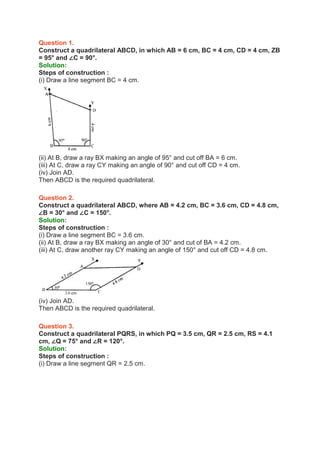
C18 18.4
- 1. Question 1. Construct a quadrilateral ABCD, in which AB = 6 cm, BC = 4 cm, CD = 4 cm, ZB = 95° and ∠C = 90°. Solution: Steps of construction : (i) Draw a line segment BC = 4 cm. (ii) At B, draw a ray BX making an angle of 95° and cut off BA = 6 cm. (iii) At C, draw a ray CY making an angle of 90° and cut off CD = 4 cm. (iv) Join AD. Then ABCD is the required quadrilateral. Question 2. Construct a quadrilateral ABCD, where AB = 4.2 cm, BC = 3.6 cm, CD = 4.8 cm, ∠B = 30° and ∠C = 150°. Solution: Steps of construction : (i) Draw a line segment BC = 3.6 cm. (ii) At B, draw a ray BX making an angle of 30° and cut of BA = 4.2 cm. (iii) At C, draw another ray CY making an angle of 150° and cut off CD = 4.8 cm. (iv) Join AD. Then ABCD is the required quadrilateral. Question 3. Construct a quadrilateral PQRS, in which PQ = 3.5 cm, QR = 2.5 cm, RS = 4.1 cm, ∠Q = 75° and ∠R = 120°. Solution: Steps of construction : (i) Draw a line segment QR = 2.5 cm.
- 2. (ii) At Q, draw a ray QX making an angle of 75° and cut off QP = 3.5 cm. (iii) At R, draw another ray RY making an angle of 120° and cut off RS = 4.1 cm. (iv) Join PS. Then PQRS is the required quadrilateral. Question 4. Construct a quadrilateral ABCD given BC = 6.6 cm, CD = 4.4 cm, AD = 5.6 cm and ∠D = 100° and ∠C = 95°. Solution: Steps of construction : (i) Draw a line segment CD = 4.4 cm. (ii) At C, draw a ray CX making an angle of 95° and cut off CB = 6.6 cm (iii) At D, draw another ray DY making an angle of 100° and cut off DA = 5.6 cm. (iv) Join AB. Then ABCD is the required quadrilateral. Question 5. Construct a quadrilateral ABCD in which AD = 3.5 cm, AB = 4.4 cm, BC = 4.7 cm, ∠A = 125° and ∠B = 120°. Solution: Steps of construction : (i) Draw a line segment AB 4.4 cm.
- 3. (ii) At A, draw a ray AX making an angle of 125° and cut off AD = 3.5 cm. (iii) At B, draw another ray BY making an angle of 120° and cut off BC = 4.7 cm. (iv) Join CD. Then ABCD is the required quadrilateral. Question 6. Construct a quadrilateral PQRS in which ∠Q = 45°, ∠R = 90°, QR = 5 cm, PQ = 9 cm and RS = 7 cm. Solution: Steps of construction : This quadrilateral is not possible to construct as shown in the figure. Question 7. Construct a quadrilateral ABCD in which AB = BC = 3 cm, AD = 5 cm, ∠A = 90° and ∠B = 105°. Solution: Steps of construction : (i) Draw a line segment AB = 3 cm. (ii) At A, draw a ray AX making an angle of 90° and cut off AD = 5 cm. (iii) At B, draw another ray BY making an angle of 105° and cut off BC = 3 cm. (iv) Join CD. Then ABCD is the required quadrilateral. Question 8. Construct a quadrilateral BDEF where DE = 4.5 cm, EF = 3.5 cm, FB = 6.5 cm and ∠F = 50° and ∠E = 100° Solution: Steps of construction : (i) Draw a line segment EF = 3.5 cm.
- 4. (ii) At E, draw a ray EX making an angle of 100° and cut off ED = 4.5 cm. (iii) At F, draw another ray FY making an angle of 45° and cut off FB = 6.5 cm. (iv) Join DB. Then BDEF is the required quadrilateral.